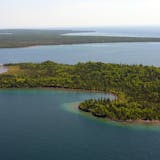David Fuhr took ocean photos of the Gulf of Mexico last year, but he wasn't on a pleasure trip.
His company, 12-employee Airborne Data Systems, Inc. of Redwood Falls, Minn., had been hired by British Petroleum to chart the Gulf oil spill with high resolution aerial photos.
Using a $700,000 digital camera designed by Airborne, a company plane spent nine weeks mapping 40,000 square miles of the Gulf. The camera was able to identify the copper-colored oil floating on top of the water by detecting its unique reflection of infrared wavelengths of light, Fuhr said. Airborne also scanned beaches for traces of oil, detecting objects as small as 2 inches, he said. BP used the information to dispatch cleanup crews.
"We did extremely fast turnaround," said Fuhr, who declined to say how much BP paid them. "We'd shoot 1,000 square miles in the morning, and have the data processed and on BP's server by 2 p.m. in the afternoon. The software fit together the separate pictures, each covering about 40 square miles."
While the oil spill was an emergency mission, Airborne's cameras have a variety of other uses: studying flood damage in the Red River Valley; determining road conditions -- down to the potholes; making crop estimates so that grain traders know how much to pay, and patrolling U.S. borders. In most cases, Airborne sells the camera and lets the customer do the flying and data processing.
Fuhr, 63, a former crop-spraying pilot who learned about cameras while doing aerial reconnaissance during the Vietnam War, co-founded Airborne in 1992 with partner Pat Woodruff, who is no longer active in management. The high-school-educated CEO, whose business is often with Ph.D.s and MBAs, describes himself on his business card as David Fuhr, R.G.; the acronym stands for "regular guy."
If the firm has any technical secret, it's the proprietary Airborne software that calibrates the camera lenses and turns the raw image data into a map with coordinates that are accurate to within a few feet, Fuhr said. Rather than make its own cameras, Airborne rebuilds industrial assembly line optical sensors, then adds the software.
But his small Minnesota firm is playing in the big leagues. Fuhr's top competitors include international lens manufacturers Leica and Carl Zeiss, said James Plasker, executive director of the American Society for Photogrammetry and Remote Sensing in Bethesda, Md.



